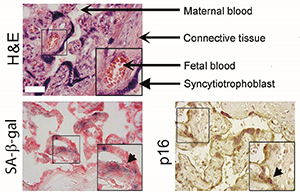
Cellular senescence during embryonic development
Cellular senescence during embryonic development
 We recently demonstrated that cell-cell fusion is a previously unidentified trigger for inducing cellular senescence. This work was the first to demonstrate that fusion-induced senescent cells exist within a normally developed placenta, within an area where physiological cell-cell fusion occurs, thereby suggesting that cellular senescence plays a role in embryonic development.
We recently demonstrated that cell-cell fusion is a previously unidentified trigger for inducing cellular senescence. This work was the first to demonstrate that fusion-induced senescent cells exist within a normally developed placenta, within an area where physiological cell-cell fusion occurs, thereby suggesting that cellular senescence plays a role in embryonic development.
In physiological conditions within the placenta, ERVWE1 mediates the formation of the multinuclear syncytiotrophoblast, which serves as the maternal-fetal interface for the exchange of gas and nutrient supplies. The syncytiotrophoblasts exhibit multiple characteristics of cellular senescence. This suggests that senescence of syncytiotrophoblasts plays a physiological role in the development and proper functioning of the placenta. Cell senescence may be important for the function of the placenta as molecular pathways of senescence contribute to the viability and function of syncytiotrophoblast during pregnancy. Further studies of different placental pathologies such as Intrauterine Growth Restriction (IUGR) and placenta accreta may shed new light on the role of fusion induced senescence in the placenta.

